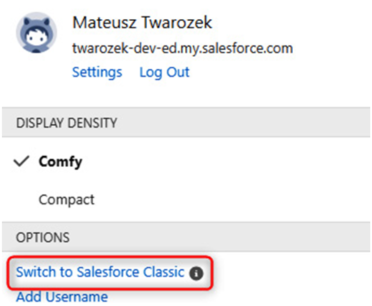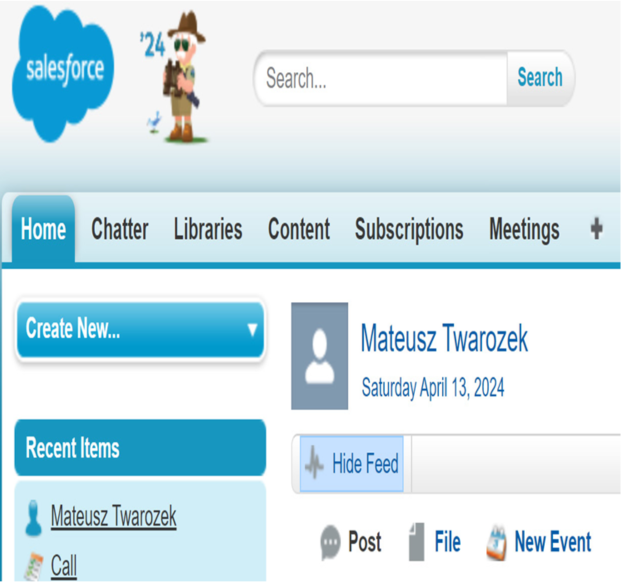Before you start reading this chapter, answer a very important question – have you ever had any experience with Salesforce Classic? No? You can very easily switch to this interface and see what the life of a user and administrator looked like some time ago. It’s very simple; let me show you in the following screenshots how to do it:
- In the top-right corner, find the little astro in out of the box (OOTB) or another icon labeled View profile (highlighted) and click on it:

Figure 4.1: View profile icon
- Then, after clicking, a new window will open with a few pieces of information, such as your user data, org name, link to Settings and Log Out, display density, Add Username, and Switch to Salesforce Classic. Don’t be afraid – press it, and here begins your Back to the Future moment:

Figure 4.2: Switch to Salesforce Classic option
- After clicking, you will be taken to the classic version of Salesforce, which looks like this:

Figure 4.3: Salesforce Classic
- You can return to the previous version in an equally simple manner. Look at the top, and you will find a small inscription with a small lightning icon labeled Switch to Lightning Experience. Simple? It seems so to me.
- When Salesforce introduced a new interface for users in 2015, it represented a kind of digital renaissance; it was a complete change for users, administrators, developers, and others associated with this system. Lightning ushered in a new era bringing improvements in terms of interface, customizing the system to user needs, and application development. Its modern look encouraged users to use it. But remember – every change has its supporters and opponents. I remember very clearly the year 2018 when I changed jobs and worked for a company that was a partner of a large consulting firm. 3 years after the premiere of Lightning, my colleagues still loved working in Classic because they could not get used to Lightning. Was it just about getting used to the new solution? Not only. Certain features are available only in Classic.
Let me describe them to you. The first one is dashboard scheduling: scheduled refreshing of dashboards and sending them by email, just like scheduled reports. Cool, right? With list view sharing in Lightning, you have the possibility to set visibility for a list view for yourself, publicly, or for roles/subordinates, whereas, in Classic, you had the possibility of sharing a list view for a group of users. Another is JavaScript buttons. Salesforce Classic supported JavaScript buttons, which allowed building logic in Java that was triggered by clicking a button. These are the three most important elements that remained in the old version, slowly already forgotten, because who uses Classic nowadays? (If you use it, raise your hand!).
In summary, the appearance of Salesforce Lightning echoed widely in the Salesforce world. It was not the introduction of, for example, Dynamic Forms, which are great, or new features for FLOW. It was a completely new interface with many conveniences. It’s as if Marc Benioff at the latest Dreamforce presented Lightning+ with a new look and functions; it would take us a moment to get used to it, wouldn’t it? But there’s no Lightning Experience without Lightning Components. Developers with their skills can do the magic using these components. See the next section of the chapter.
